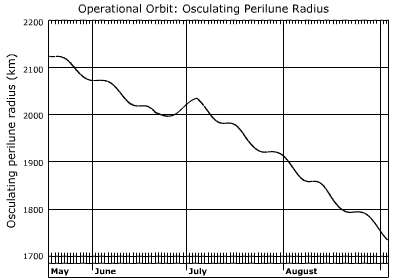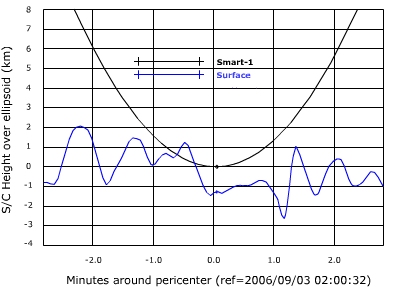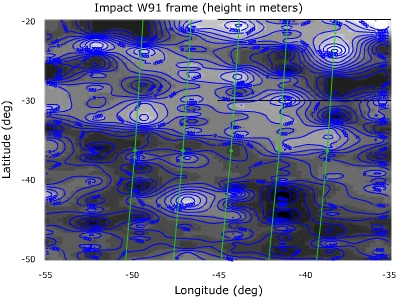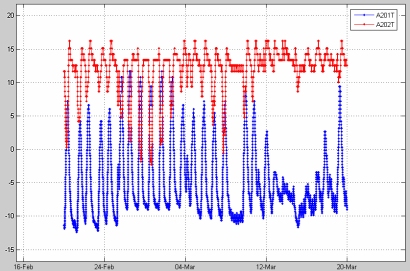No. 49 - Small Drop in Solar Array Power
The payload operations have also run as planned and D-CIXS successfully uploaded a software patch.
SMART-1 is aiming at being the first ESA mission to command spacecraft operations automatically. The Ground Operations Automation Review (GOAR) took place on 16 March 2006. The board assigned some actions and called for a delta review to be done on 31 March.
End-of-Mission Planning
All information relevant to the impact of SMART-1 is being consolidated at the moment:
- Flight Dynamics (FD) has completed the analysis of the end-of-mission planning
- The FD analysis will be complemented with a technical note being produced by the SSC and a thermal simulation being done at ESTEC
- The SMART-1 Principal Investigator, Bernard Foing is also coordinating the Moon Smart Impact, predictions and observation campaign
Without any changes to its orbit, SMART-1 would impact the Moon around 17 August 2006. However, science requirements have asked for pushing back this date to 3 September. To achieve this extension, the perilune distance will be increased by a series of perilune raising manoeuvres from the end of June through early July. The perilune raising manoeuvre strategy details are as yet to be finalised.
The accuracies of the planned delta-V generation using RWOL doesn't allow phasing control. Consequently, the time of the selected impact perilune may shift during the perilune raising manoeuvres. If the shift exceeds a certain amount, a new perilune can be selected. To support this selection the project scientist defines a slot of 5.5 hours for the impact. This slot will always contain one and usually only one perilune.
The initial state prior to perilune raising manoeuvres, on 18 May 2006:
- Radius of perilune = 2124 km (Moon radius = 1738 km)
- Radius of apolune = 4714 km
- Coordinate system = Z-axis towards Moon north pole of date, X-axis towards descending node of Earth equator of epoch 2000 w.r.t. Moon equator of date
- Inclination = 90.6°
- Right ascension of ascending node = 239.3°
- Argument of perilune = 232.2°
- Xenon left = 0.260 kg (0.060 kg usable with special operations)
- Hydrazine left = 6.3 kg
The current plan for the perilune raising manoeuvre comprises:
- 63 revolutions with about 3 hours of intermittent thrust centred around apolune
- Thrust direction along the velocity with some in-plane tilt when away from apolune
- Total delta-V = 12.032 m s-1
- Total hydrazine usage = 2.6 kg
- Total perilune raising = 90 km
- Total duration = 14 days + 3 days (halt for orbit determination and delta-V calibration)
- Start date = 21 June 2006 (end of push broom operations)
- End date = 8 July 2006
- Slots for trim = 26-27 July 2006 and 30-31 August 2006
- Current impact time prediction = 3 September 2006, 02:00 UTC
Around impact, the perilune reduces 1.2 km per revolution. Clementine data provided by the Science and Technology Operations Centre (STOC) are used for the Moon topography. The accuracy of this model is still to be determined and should be provided by the STOC. To guarantee impact at the selected perilune, trims of the perilune altitude have to be introduced. These correct for propagation uncertainty in the perilune altitude which may be up to 1.0 km per month, caused by for example uncertainties in the Moon gravity field. Without these trims, impact may occur 1 revolution earlier or later.
 |
|
Expected evolution of the perilune radius from 18 May to 3 September. Note the increase at the start of July due to the perilune raising manoeuvres. |
 |
|
Height above lunar surface for the nominal impact orbit on 3 September 2006, 6 minutes around the perilune. |
 |
|
Position of the perilune on the lunar surface for the nominal impact orbit (central green line), plus 2 additional orbits on either side of the impact orbit. The successive perilune points are indicated by the 5 squares (from right to left). The blue lines indicate surface levels. |
Future Activities
The future activities are focused on:
- Finalising the end of mission impact on the Moon analysis
- Tone ranging test on SMART-1 with Chinese CLTC Kashi station and with ISRO
- Start using the SMART-1 Ground Operations Automation System (S1 GOAS)
- Preparation of papers for Spaceops and IAA in Valencia
Spacecraft Status
The spacecraft status is good with all functions working nominally.
AOCS
The AOC subsystem has done well in the period covered by this report. Most noticeable during this period were four double blindings between 3 and 5 March 2006, and a suspected glitch in the startracker software. This internal startracker problem caused an autonomous reboot of the startracker on 5 March 2006 at 01:06:39, leaving the spacecraft without startracker data for only a couple of seconds and causing no harm.
The startracker has had no problems with temperature during the reporting period. The below figure shows the startracker CCD temperatures for the period covered by this report. The table below lists the temperature statistics for this period. Note that the startracker starts having problems when the temperature is higher than 19°.
 |
|
Temperature (°C) of the startracker CCDs for the reporting period: CHU1 (blue) and CHU2 (red). |
The following table lists the temperature statistics for this period.
| Camera Head Unit | Min. T (°C) | Max. T (°C) | Average (°C) |
| CHU1 | -12.36 | +11.66 | -6.6 |
| CHU2 | -2.27 | +16.24 | +11.92 |
TT&C
The performance of the TTC subsystem has been nominal during this period.
EP, Power and Thermal
The performance of the Power and Thermal Subsystems during the reporting period was very good. The small drop in power, possibly indicating a loss of one subsection of the solar array at +Y panel, is no problem for the daily operations.
Orbital Information
| SMART-1 OD415, Close to Apolune 2093 Epoch (UTC) 2006/03/20 08:29:41.4 Elements WRT Moon and its equator of date | |
| Pericentre Distance (km) | 2299.558770 |
| Apocentre Distance (km) | 4537.902013 |
| Semi Major Axis (km) | 3418.730391 |
| Eccentricity | 0.327365 |
| Inclination (°) | 90.678149 |
| Ascending Node (°) | 238.986563 |
| Argument of Pericentre (°) | 244.990510 |
| True Anomaly (°) | 179.999998 |
| Osculating Orbital Period (h) | 4.982560 |
The changes since apolune 2059 are as follows:
- semi-major axis -0.3 km
- perilune height -18.2 km
- apolune height +17.5 km
- orbital period -0.0 min
